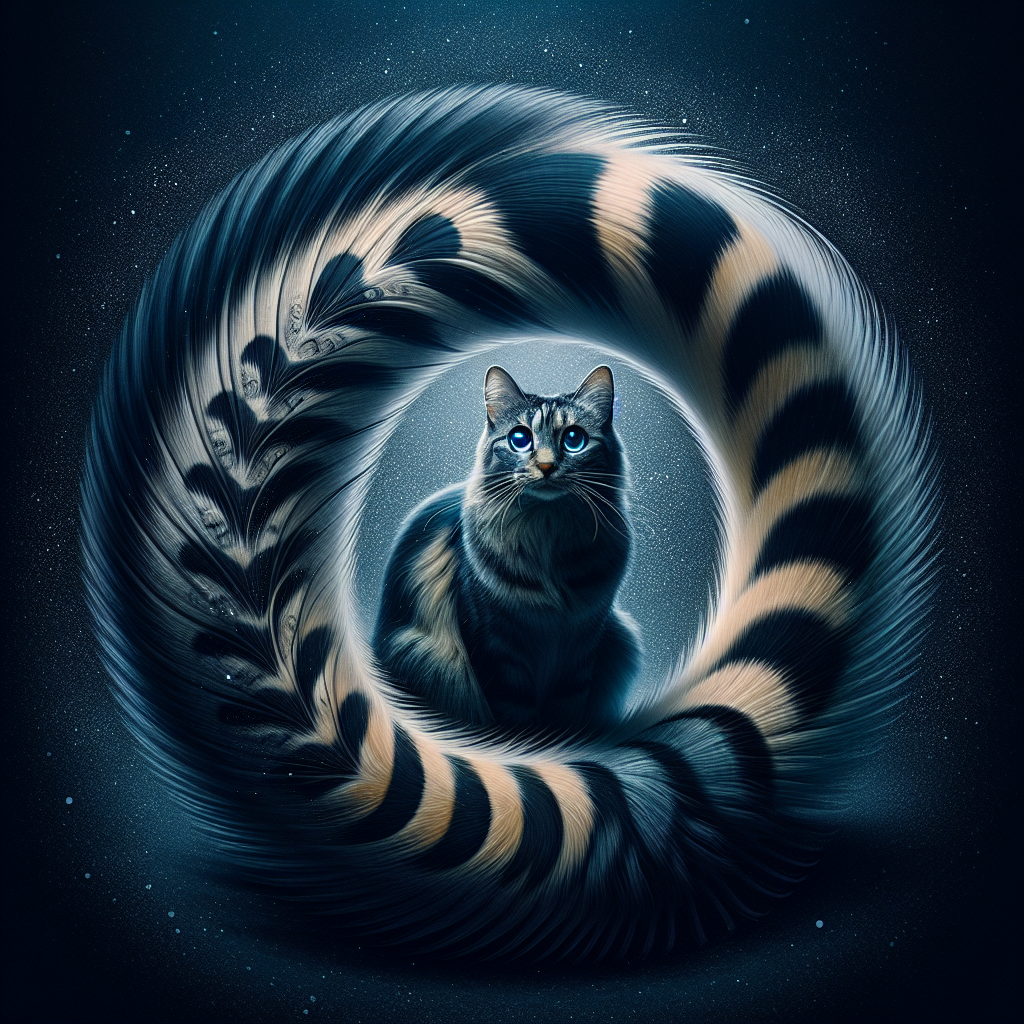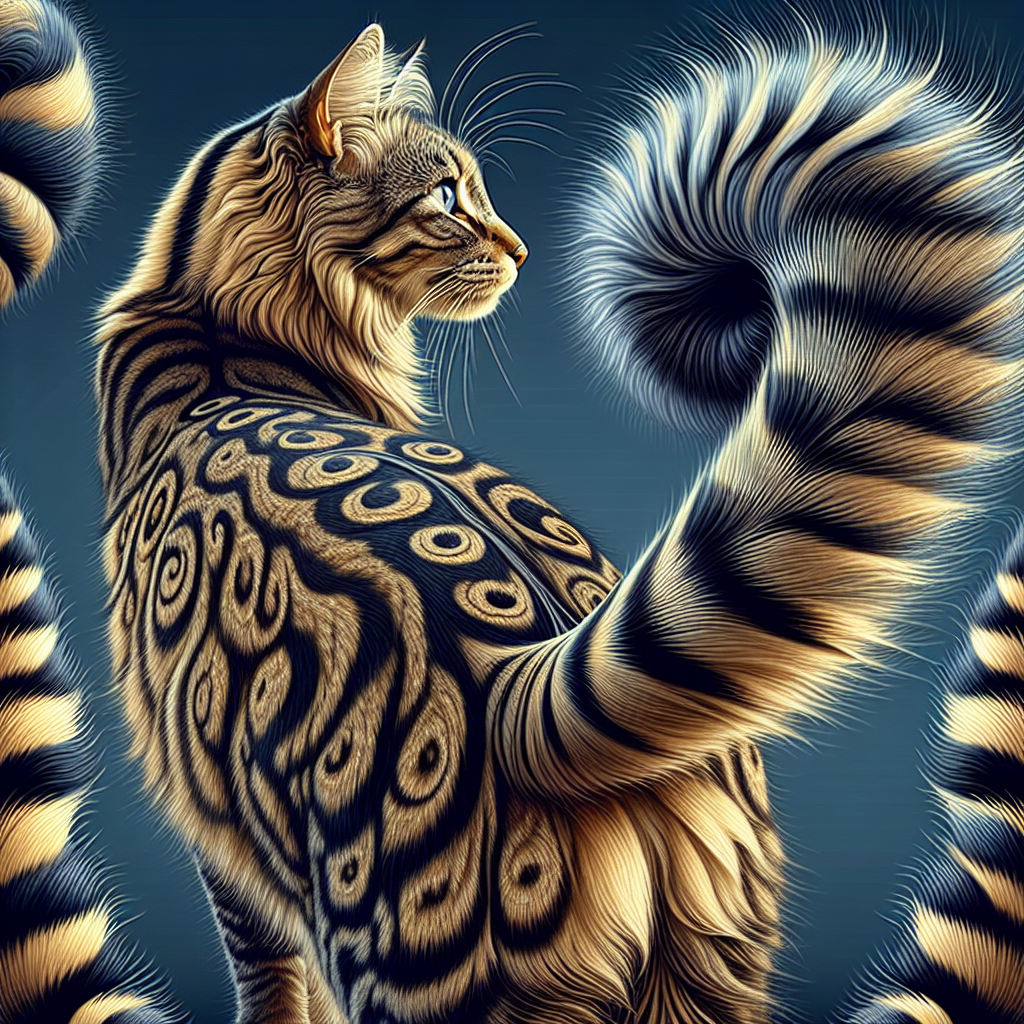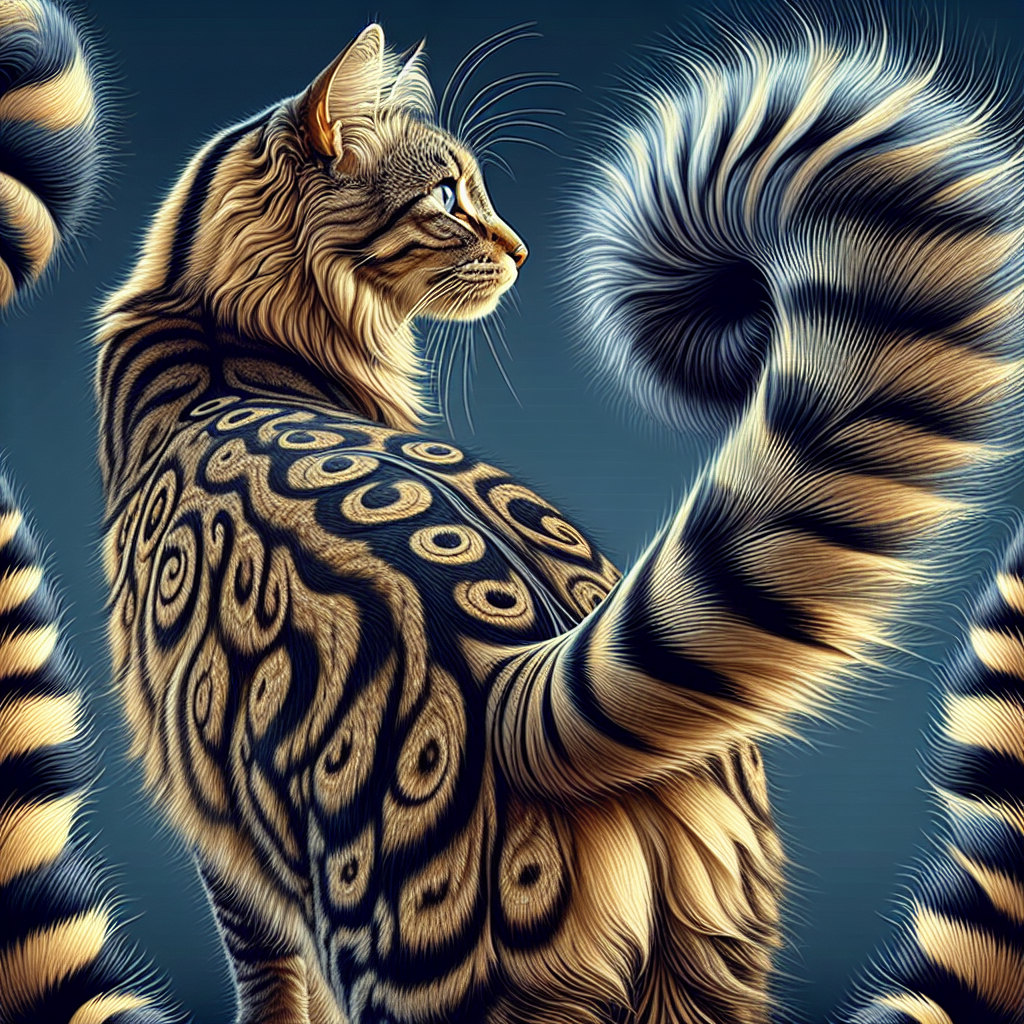Have you ever wondered if tabby cats typically have rings on their tails? Tabby cats are known for their distinctive coat patterns, characterized by swirling stripes, spots, and dots. While these patterns can vary greatly, one feature often seen on tabby cats is rings on their tails. These rings can appear as dark bands encircling the tail, adding to the overall charm and allure of these delightful feline companions. In this article, we will explore whether tabby cats indeed typically have rings on their tails, delving into the factors that contribute to this unique characteristic. So, whether you’re a proud owner of a tabby cat or simply curious about feline genetics, read on to uncover the fascinating truth about tabby tail rings.
Tabby Cats
What is a tabby cat?
Tabby cats are one of the most common and beloved domesticated cat breeds. They are not a specific breed, but rather a coat pattern that can be found in many different breeds, including the American Shorthair, Maine Coon, and Siamese. Tabby cats are known for their distinctive coat patterns, which often include stripes, swirls, and spots. These patterns can vary greatly in color and intensity, resulting in a unique and eye-catching appearance.
Tabby cat coat patterns
Tabby cat coat patterns can be classified into four main types: classic, mackerel, ticked, and spotted. The classic tabby pattern consists of bold, swirling patterns on the cat’s sides, resembling the letter “M” on their forehead. The mackerel tabby pattern is characterized by thin, straight stripes that run from the cat’s spine to their belly. The ticked tabby pattern, also known as agouti, gives the fur a salt-and-pepper appearance, with each individual hair having bands of different colors. The spotted tabby pattern features spots or blotches on the cat’s coat, creating a unique and striking look.
Traits of tabby cats
While the coat pattern is the defining characteristic of a tabby cat, there are a few other characteristics that are commonly associated with these feline friends. Tabby cats are often praised for their friendly and sociable nature. They tend to be outgoing and enjoy interacting with their human companions. In addition, tabby cats are known for their intelligence and playfulness. They thrive on mental and physical stimulation, making them great partners for interactive play and training.
Tail Features
Length of the tail
The length of a tabby cat’s tail can vary depending on the breed and individual cat. On average, most tabby cats have tails that range from 9 to 11 inches in length. However, there are exceptions, and some tabby cats may have shorter or longer tails. It’s important to note that the length of a cat’s tail is not directly correlated with its overall health or personality traits.
Shape of the tail
Tabby cats can have tails with various shapes, ranging from straight and slender to fluffy and curved. The shape of a cat’s tail is influenced by factors such as genetics and individual variation. Some tabby cats may have tails that are slightly bent or curved, adding an extra touch of uniqueness to their appearance. However, it’s essential to monitor the tail’s shape to ensure it has not been injured or affected by any abnormalities.
Possible tail abnormalities
While uncommon, tabby cats can experience tail abnormalities that may affect their tail’s appearance or functionality. These abnormalities can include kinks, bends, or even amputations due to accidents or medical conditions. It’s important to observe your tabby cat’s tail regularly and seek veterinary attention if you notice any changes or abnormalities that may require medical intervention.

Tabby Cat Tails
Variations in tabby cat tail patterns
Just as tabby cats can have unique coat patterns, they can also exhibit variations in their tail patterns. Some tabby cats may have tails with prominent markings that resemble rings or bands, while others may have tails with minimal or no visible markings. The tail patterns can add to the overall aesthetic appeal and charm of a tabby cat, making each feline companion truly one-of-a-kind.
Rings on the tail
One of the intriguing tail patterns that can be observed in tabby cats is the presence of rings. These rings can either encircle the entire tail or appear as partial rings. They can be of varying thickness and intensity, ranging from bold and defined to subtle and faint. The rings can be lighter or darker in color compared to the rest of the cat’s coat, creating a visually appealing contrast.
Potential causes of tail rings
The exact cause of tail rings in tabby cats is not fully understood. It is believed that the presence of tail rings is primarily attributed to genetic factors. Certain genes may influence the development and distribution of pigments in the tail, resulting in the formation of visible rings. However, environmental factors can also play a role in the intensity and appearance of tail rings. Factors such as exposure to sunlight and variations in temperature can potentially affect the pigmentation and coloration of the tail.
Ringless Tails
Tabby cats without tail rings
While rings on the tail are often associated with tabby cats, it’s important to note that not all tabby cats have this distinctive feature. Many tabby cats exhibit coat patterns without any visible rings on their tails. This variation in tail appearance is what makes tabby cats so diverse and unique. Whether a tabby cat has rings or not, they are equally adorable and cherished by their owners.
Genetic factors
The absence of tail rings in tabby cats can also be influenced by genetic factors. Just as specific genes can result in the presence of rings, other genes may suppress or modify their expression. Genetic variations and combinations play a significant role in determining the appearance of a tabby cat’s tail, including the presence or absence of rings.
Environmental factors
In addition to genetics, environmental factors can affect the appearance of a tabby cat’s tail. Exposure to certain environmental conditions, such as temperature, humidity, and sunlight, can influence the pigmentation and coloration of the tail. It’s important to provide a comfortable and balanced environment for tabby cats to thrive, as this can contribute to the overall health and appearance of their tails.

Ring Patterns
Types of tail ring patterns
Tabby cat tail rings can exhibit various patterns, each with its own unique charm. The most common types of tail ring patterns observed in tabby cats include the bullseye pattern, the classic or bracelet pattern, and incomplete rings. These patterns are visually captivating and contribute to the overall aesthetic appeal of the cat’s tail.
Bullseye pattern
The bullseye pattern is characterized by distinct and well-defined rings that encircle the tabby cat’s tail. The rings are often evenly spaced and of consistent thickness, creating a classic and symmetrical appearance. This pattern is particularly eye-catching and is often admired by cat enthusiasts.
Classic or bracelet pattern
The classic or bracelet pattern consists of rings that resemble bracelets placed around the tabby cat’s tail. These rings can vary in thickness and intensity, adding flair and visual interest to the tail. The classic pattern is timeless and elegant, embodying the quintessential charm of tabby cats.
Incomplete rings
Another variation in tail ring patterns is the presence of incomplete rings. These rings may appear broken or irregular, adding a touch of uniqueness and individuality to the tabby cat’s tail. Incomplete rings can be seen as an artistic feature on the tail, giving a playful and whimsical character to the cat’s overall appearance.
Ring Development
Rings forming during kittenhood
The development of tail rings in tabby cats often occurs during their kittenhood. As tabby kittens grow, their coat patterns start to become more defined, including the patterns on their tails. Initially, the rings may be faint or barely visible, but they tend to become more pronounced and prominent with time. It’s a delight to witness these unique patterns taking shape as the kitten matures into a beautiful adult tabby cat.
Optical illusion of tail rings
In some cases, what may appear as tail rings on a tabby cat could actually be an optical illusion caused by the distribution and arrangement of fur. The combination of fur color, texture, and patterns can create the illusion of rings or bands on the tail, enhancing the cat’s visual appeal. This optical phenomenon adds an element of intrigue and mystery to the tabby cat’s appearance, making them even more captivating to observe.
Changes in tail ring appearance with age
As tabby cats age, their tail rings may undergo changes in appearance. The vibrancy and intensity of the rings can fade or mellow over time, resulting in a more subdued or muted appearance. However, this gradual change should not be cause for concern. Aging is a natural process, and just like humans, tabby cats may experience subtle alterations in their physical characteristics as they mature.
Genetics
Inheritance of tabby cat traits
Tabby cat coat patterns, including the presence or absence of tail rings, can be inherited from their parents. The specific genes responsible for these traits are complex and can interact in various ways, leading to individual variation among offspring. The inheritance of tabby cat traits follows certain patterns, with certain genes being dominant or recessive. Understanding the genetic basis of tabby cat traits can help breeders and cat enthusiasts predict and selectively breed for desired coat patterns and tail ring appearances.
Genes responsible for coat patterns
Several genes have been identified as playing a role in the development of tabby cat coat patterns. One of the key genes is the agouti gene, which controls the distribution of pigments along the hair shaft. Another important gene is the tabby gene, which determines the pattern and shape of the stripes or spots on the coat. These genes work together in complex ways, interacting with other genetic factors to produce the wide range of coat patterns observed in tabby cats.
Role of genetics in tail ring presence
The exact genes responsible for the presence or absence of tail rings in tabby cats have not yet been fully identified. It is believed that multiple genes are involved in determining the intensity and appearance of tail rings. Additionally, genetic factors may interact with environmental conditions and influences to shape the final outcome of the tail ring pattern. Continued research and genetic studies are essential for unraveling the intricate mechanisms that contribute to the diversity and individuality of tabby cat tails.
Tail Health
Possible health issues related to tabby cat tails
The tail is an important part of a cat’s anatomy, and it is crucial to monitor its health and condition. While tabby cats do not have any specific tail-related health issues associated with their coat pattern, there are general concerns that all cat owners should be aware of. Obesity can pose a risk to a cat’s tail health, as excess weight can put strain on the tail and potentially lead to issues such as decreased mobility or even infection. Additionally, tail injuries, such as bites, accidents, or trauma, can result in deformities or complications that require veterinary attention.
Obesity and tail rings
While there is no direct link between tail rings and obesity in tabby cats, it’s important to consider the overall health and well-being of the cat. Obesity can affect various aspects of a cat’s health, including its tail. Excess weight can put strain on the tail and potentially lead to discomfort or limited mobility. Maintaining a healthy weight through proper nutrition and regular exercise can help promote not only the overall health of the cat but also the well-being of its tail.
Tail injuries and ring deformities
Tail injuries can occur in any cat, regardless of their coat pattern. In tabby cats, tail injuries can sometimes result in deformities that may affect the appearance or functionality of the tail rings. Accidents, bites, or trauma can cause fractures, dislocations, or other injuries that require veterinary care. Prompt medical attention and proper treatment are essential for ensuring the tail’s optimal healing and minimizing the risk of long-term complications.
Tail grooming and care
Regular grooming and care are important for maintaining the health and appearance of a tabby cat’s tail. Brushing the tail helps remove loose hair, prevents matting, and stimulates circulation. It’s also advisable to periodically check the tail for any signs of injury, infection, or abnormalities. Maintaining proper hygiene and providing a comfortable environment for the cat to groom itself can contribute to healthy tail development and overall well-being.
Personalities and Behaviors
Do tail rings indicate specific personality traits?
The presence or absence of tail rings in tabby cats does not indicate specific personality traits. Personality in cats is influenced by a combination of genetic factors, individual experiences, and environmental influences. While tabby cats are generally known for their friendly and sociable nature, this characteristic is not directly linked to the presence or absence of tail rings. Each tabby cat has a unique personality, regardless of their tail ring patterns, and should be appreciated for their individuality and personal charm.
Impact of tail ring presence on behavior
The presence of tail rings does not directly impact a tabby cat’s behavior. Tail movements and behaviors in cats are complex and multifaceted, serving as a form of communication and expression. A tabby cat’s tail may wag, twitch, or stand upright for various reasons, such as excitement, curiosity, fear, or aggression. These behaviors are not influenced by the presence or absence of tail rings. It’s important to consider the overall context and body language of the cat when interpreting their behavior.
Tail movement and communication
A tabby cat’s tail movements can provide insight into their current emotional state and communication. A tail held high indicates confidence and excitement, while a tail held low or tucked between the legs suggests fear or submission. Twitching or swishing of the tail can indicate agitation or annoyance, while a rapidly wagging tail may signal aggression. It’s essential to observe the entire body language of the cat, including the tail, to interpret their behaviors accurately and provide appropriate responses and care.
Conclusions
Summary of tabby cats and tail rings
Tabby cats are beloved feline companions known for their distinctive coat patterns, which often include various types of rings on their tails. These tail rings can add a unique charm and visual appeal to the cat’s overall appearance. However, not all tabby cats have tail rings, as their presence or absence can vary depending on genetic and environmental factors. The development and appearance of tail rings may change over time, and individual variation is a key characteristic of tabby cats.
Importance of individual variation
Every tabby cat is truly one-of-a-kind, and their appearance, including their tail rings, contributes to their individuality. It’s important to appreciate and celebrate the diversity and uniqueness of each tabby cat, whether they have rings on their tail or not. Individual variation adds to the charm and allure of the tabby cat breed, making them a beloved and cherished companion for many cat enthusiasts.
Appreciating tabby cats with or without rings
Tabby cats, with or without tail rings, are equally adorable and deserving of love and care. Whether a tabby cat’s tail exhibits rings, spots, or stripes, their playful and sociable nature, combined with their striking coat patterns, make them a joy to have as a companion. As cat lovers, let’s embrace and appreciate the enchanting beauty and individuality of tabby cats, celebrating their unique tail features and all the love and happiness they bring into our lives.

